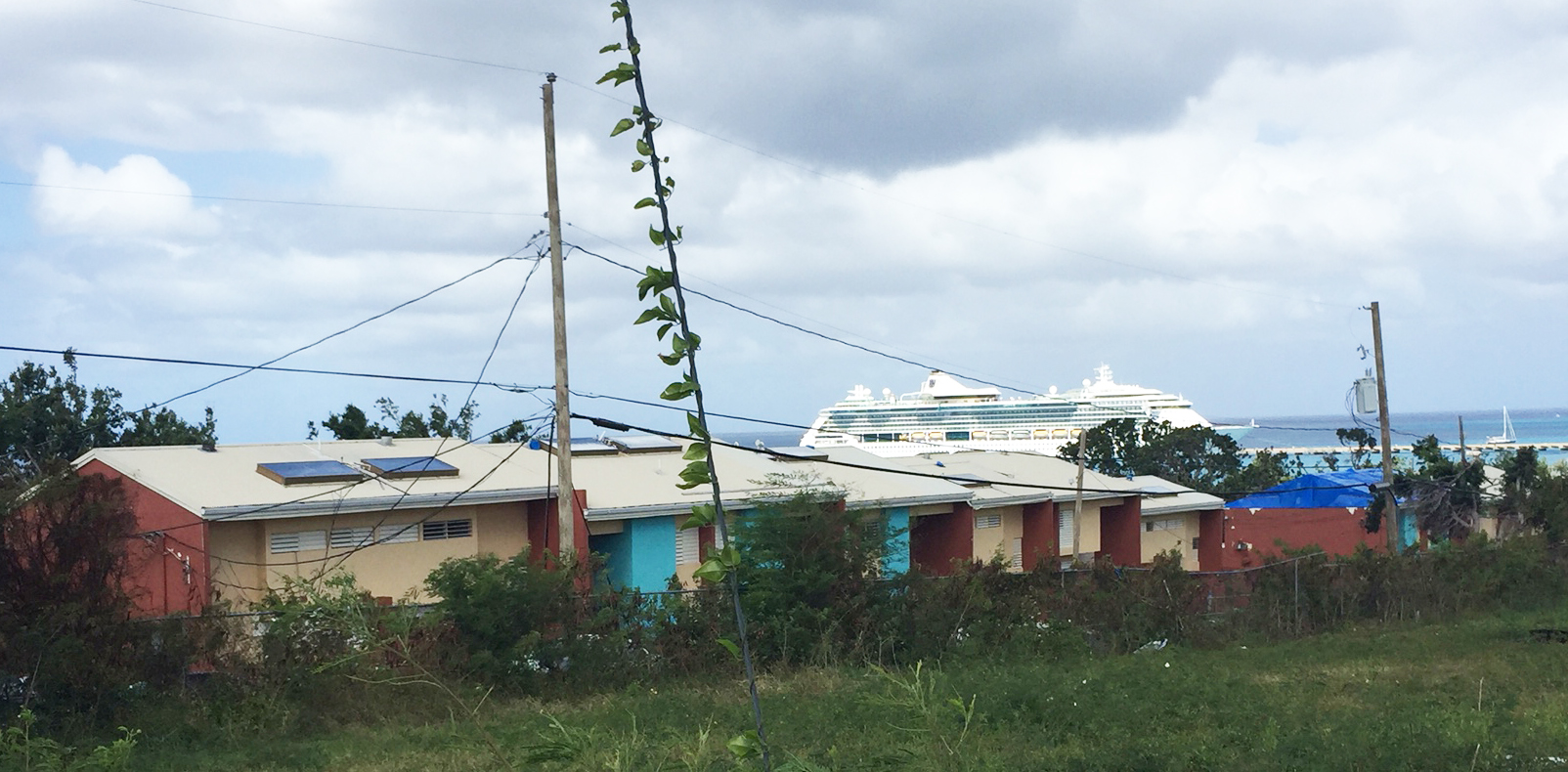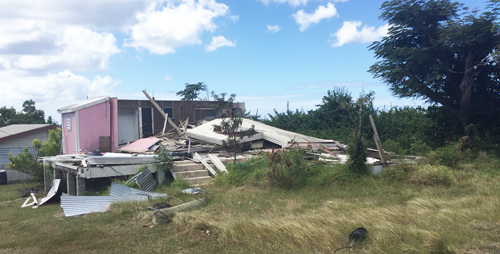U.S. Virgin Islands still suffering months after hurricanes hit...
 While luxury cruise ships (background above) continue receiving special treatment, residents of the U.S. Virgin Islands have been shortchanged in hurricane relief for more than five months. Substance photo by Susan Hickey.Most of the people who live in the U.S. Virgin Islands are -- like the people of Puerto Rico -- still suffering months after huge hurricanes hits the islands. The media has moved on to other stories since Hurricane Irma and Maria left death and destruction in the Caribbean which includes Puerto Rico and the Virgin Islands. I went to see how Saint Croix was faring and to visit my daughter who lives there.
While luxury cruise ships (background above) continue receiving special treatment, residents of the U.S. Virgin Islands have been shortchanged in hurricane relief for more than five months. Substance photo by Susan Hickey.Most of the people who live in the U.S. Virgin Islands are -- like the people of Puerto Rico -- still suffering months after huge hurricanes hits the islands. The media has moved on to other stories since Hurricane Irma and Maria left death and destruction in the Caribbean which includes Puerto Rico and the Virgin Islands. I went to see how Saint Croix was faring and to visit my daughter who lives there.
[img=9926]After getting off the plane and being driven toward Frederiksted, you would notice that the roads which were never well paved had more than their share of potholes which could cause serious damage to your car. There were no traffic lights or street signs. There were few street lights working and it was pitch black most of the way. It would have to wait in the morning to see how the island was recovering.
Saint Croix is a place of extremes with luxury villas owned by the 1% who go down there to escape the winter cold in the States. Joe Biden has a place there and it is an island joke that the roads leading to his mansion are well paved unlike the ones the islanders must use daily. The majority of the expensive homes are on the east part of the island and they had power and water within a week after Hurricane Maria hit the island. Christiansted had power mainly due to the fact the lines were underground and they suffered little damage. You cannot say the same for the west part of the island which is where Frederiksted is located. Frederiksted has electricity now for the most part. The vast majority got their electrical hook up at the end of January, almost five months after the storm.
[img=9927]Linemen are still there on Saint Croix putting the finishing touches on the restoration of power. The old poles and electrical wires are still there with some dangling or on the ground. There is no timetable for when they will be removed. There was a cruise ship in the Frederiksted harbor for FEMA and linemen's living quarters. It was difficult for the Crucians (the proper names for people born on Saint Croix) to see them leave to go to a ship that had all the amenities needed while they had to do without basic necessities.
Recently, the cruise ship left and the US government leased an Italian ferry. I found out from a wife of a lineman when I was flying back home that the US government is paying $500 a day per room to the ship’s company. The ferry has half the living quarters that the cruise ship had and the others were put up in resorts or apartments in Frederiksted. This has caused a problem for the islanders as the rents were increased as the US government is paying it. It is a typical thing that happens. There are very few places for the people of Saint Croix to live. You can see tents around the area where they are forced to live.
[img=9928]Traveling around Frederiksted, you can see many houses that are flattened or badly damaged. There are large piles of storm debris everywhere. Many houses still have blue tarps on them and it will be a long time they will have permanent roofs. Where I was staying, there were the bones of a dog that died recently and I was told that dead animals are everywhere rotting. Going into the center of the town, one will notice that most of the businesses are gone with very few places open for people to buy daily essentials. You need transportation to go to the closest supermarket which is better stocked now. You still have problems getting fresh fruit and vegetables. There is a K-Mart that recently reopened after dealing with mold and other issues. There is a temporary post office opened for residents to pick up their mail but they must travel to another post office to ship packages. The palm trees that are still standing have an eerie appearance with its branches only on the side that faces west away from the hurricane’s path. Centuries old mahogany trees were uprooted and many are still there on their sides.
 Hundreds of homes and other buildings were destroyed during the hurricanes. Months afterwards (above) the ruins still dot the landscape of the U.S. Virgin Islands, just as they do in Puerto Rico. Substance photo by Susan Hickey.One consequence of this is that a part of Crucian history is exposed. There are pieces of eighteenth century pottery which are called chaney that you can pick up. There is always a chance to find some after it rains there but the hurricane exposed a lot more. The pottery was seized by Crucian slaves from their Danish masters after their emancipation and broken as a form of celebration. Slowly the trees and other vegetation are coming back but it will take time to have some semblance of normalcy especially for the growth of mahogany trees.
Hundreds of homes and other buildings were destroyed during the hurricanes. Months afterwards (above) the ruins still dot the landscape of the U.S. Virgin Islands, just as they do in Puerto Rico. Substance photo by Susan Hickey.One consequence of this is that a part of Crucian history is exposed. There are pieces of eighteenth century pottery which are called chaney that you can pick up. There is always a chance to find some after it rains there but the hurricane exposed a lot more. The pottery was seized by Crucian slaves from their Danish masters after their emancipation and broken as a form of celebration. Slowly the trees and other vegetation are coming back but it will take time to have some semblance of normalcy especially for the growth of mahogany trees.
[img=9929]The hospital is operating but lost its accreditation before the storm. People are afraid to be admitted into the hospital in fear of getting MERSA. The health clinic is also open and almost all of the Crucians are dependent on governmental health coverage which is precarious given the GOP led Congress ready to slash that budget so that Trump can get his wall and the 1% can get their tax cuts. The mental health services are for the most part nonexistent. I watched as my daughter sleeps very little being wakened by nightmares reliving the night that Hurricane Maria tore off the roof of her home with the ceiling crashing down on her and her friends. They managed to get themselves crammed in a closet with the exception of one who was knocked unconscious by falling plaster.
Tourism is an important part of the Caribbean economy, and the weekend I was there, two cruise ships came into the Frederiksted harbor. The streets were blocked off so that Crucians were not able to drive in their own town in order that tourists can wander around, marveling at the quaint historical district without having to have too much contact with “natives”. Tourists were shielded from seeing the reality of the devastation that is the daily life of Crucians.

